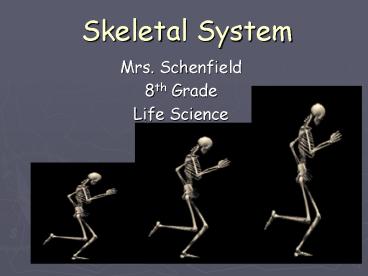Skeletal System - PowerPoint PPT Presentation
1 / 54
Title:
Skeletal System
Description:
Skeletal System Mrs. Schenfield 8th Grade Life Science Joints of the Body Ball and Socket Joint: Round end of bone fitting snuggly within another bone. Ex. Shoulder ... – PowerPoint PPT presentation
Number of Views:295
Avg rating:3.0/5.0
Title: Skeletal System
1
Skeletal System
- Mrs. Schenfield
- 8th Grade
- Life Science
2
5 Functions of the Skeletal System
- 1. Movement Skeletal system provides points of
attachment for muscles. Your legs and arms move
when the muscles pull on the bones. - 2. Support The backbone is the main support
center for the upper body. It holds your head up
and protects your spinal cord.
- Muscle attached to bones!!
3
5 Functions of the Skeletal System
- 3. Protection The bones of your skull protect
your brain. Your ribs protect your lungs and
heart from injury. - 4. Makes Blood Red and white blood cells are
formed by tissue called marrow, which is in the
center of the bone.
4
5 Functions of the Skeletal System
- 5. Storage Bones store minerals, such as calcium
and phosphorus, for use by the body
5
Two Major Skeletal System Parts
- Axial Skeleton The axial skeleton includes the
skull, spine, ribs and sternum. - Appendicular Skeleton The appendicular skeleton
includes the appendages of the body, which are
the shoulders, arms, hips, and legs.
6
Skeletal System Bones
- Four basic bone shapes
- 1. Long- arms, legs and fingers
- 2. Short- wrist and ankles
- 3. Flat- skull and sternum
- 4. Irregular- spine
7
Bone Structure
Hyaline cartilage - covers the ends of the bones,
stops them rubbing together and absorbs
shock. Epiphysis- the head of the
bone. Cancellous bone - spongy bone that stores
the red bone marrow where blood cells are made.
8
Bone Structure
Epiphyseal plate the area where bones grow in
length. Diaphysis - the shaft. Compact bone
hard, dense bone. It gives strength to the hollow
part of the bone.
9
Bone Structure
Periosteum a protective layer where there is no
hyaline cartilage. Ligaments and tendons attach
to the periosteum. Medullary cavity/marrow cavity
- contains the yellow bone marrow where white
blood cells are made.
10
Bone Growth
11
Bone Growth
12
Bones of the Cranium
- Some are thicker
- than others!!!
13
Bones of the Skull Sutures
14
Maxilla and Mandible
?
Maxilla
Mandible
15
Clavicle or Collarbone
- The clavicle, or collar bone, holds the shoulder
joint away from the rest of the upper body and is
only as thick as your little finger.
16
Scapula
- The scapula is located on the back side of the
ribcage and helps provide part of the shoulder
joint and movement for the arms.
17
Vertebral Column or Spinal Cord
- 1) The cervical region (neck bones)
- 2) The thoracic region (what the ribs attach to)
- 3) The lumbar region (the lower part of the back)
18
Coccyx and Sacrum
19
Humerus (Upper Arm Bone)
20
Radius and Ulna
- Radius on Top
- Ulna on Bottom
21
Carpals or (Wrist Bones)
22
Metacarpals (Top of Hands)
23
Phalanges (Little Fingers)
24
Rib Cage
25
Thoracic Cage
26
Sternum (Breastbone)
27
Pelvis (Dancing Bone)
28
Femur (Largest Bone in the Body)
29
The Tibia and Fibula
30
Tarsals
31
Metatarsals
32
Phalanges
33
Calcaneous
34
Joints of the Body
- Ball and Socket Joint Round end of bone fitting
snuggly within another bone. - Ex. Shoulder and Hip
35
Joints of the Body
- Hinge Joint Movement at joint in one direction
like a door. - Ex. Knee and Elbow
36
Joints of the Body
- Pivot Joint Bone resting atop another bone
permitting free movement. - Ex. Neck, Wrist and Ankles
37
Joints of the Body
- Fixed Immovable Joint does not move
- Ex. Skull
- Gliding Joint Bones slipping over other bones
with a free flowing movement. - Ex. Knuckles
38
Types of Joints (articulations)
- Synarthrotic (not moveable, aka sutures)
- Amphiarthrotic (slightly moveable, vertebrae)
- Diarthrotic (moveable joint, aka synovial joints)
39
Synovial fluid - fluid within the joints that
helps to lubricate Types of Joints 1. Ball and
Socket 2. Hinge 3. Pivot 4. Saddle
40
The Connectors of the Body
- Ligaments Connect bone to bone
41
The Connectors of the Body!!
- Tendon Attaches muscles to bones
42
The Connectors of the Body
- Cartilage It acts as a cushion between bones at
a joint and protects the bones.
43
Problems of the Skeletal System
- Fracture Break
- Dislocation Out of joint
44
Types of Fractures
- Complete fracture-break involving the entire
width of the bone
- Incomplete fracture-only a crack in the bone
45
Types of Fractures
- Comminuted fracture-bone is broken into several
pieces
- Open fracture-broken bones is open through the
skin
46
Problems of the Skeletal System
- Sprain Swelling in the joint
- Arthritis Inflamed and stiff joints
47
Problems of the Skeletal System!!
- Scoliosis Curvature of the spine
- Osteoporosis Brittle bones
48
Rheumatoid arthritis is an autoimmune disease
which causes joint stiffness and bone deformity
Source http//www.thetimes.co.uk/tto/public/artic
le3233439.ece
49
(No Transcript)
50
(No Transcript)
51
In a compound fracture, also called an open
fracture, the bone breaks through the skin. It
may then recede back into the wound, so it is no
longer visible through the skin. In a simple
fracture, also called a closed fracture, the bone
breaks but there is no open wound in the skin.
52
Greenstick fracture an incomplete fracture in
which the bone is bent. This type of fracture
occurs most often in children.
53
Comminuted fracture a fracture in which the bone
fragments into several pieces.
54
(No Transcript)































